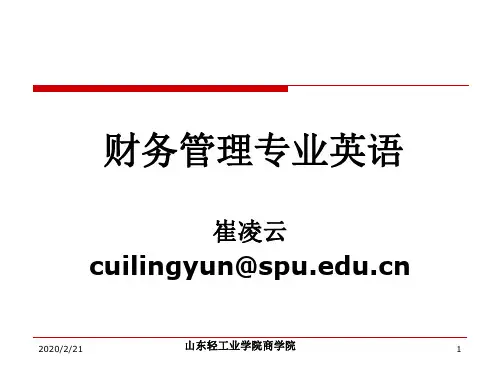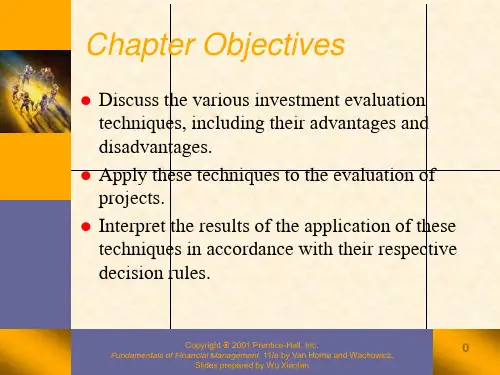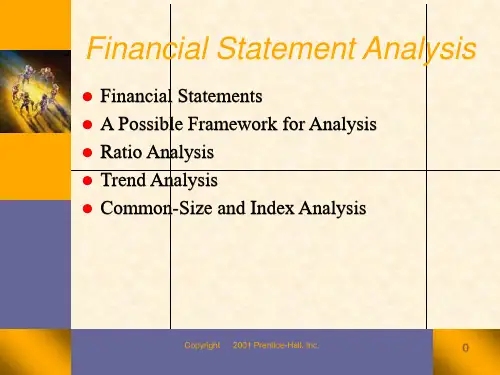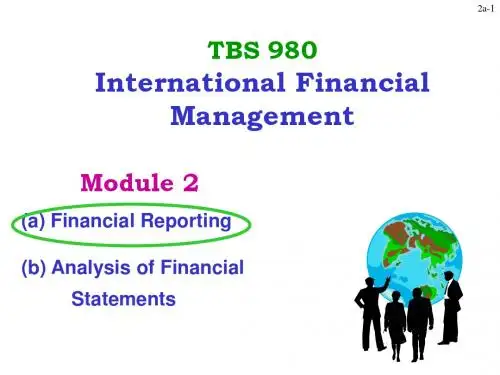新财务管理专业英语 教学课件 崔刚主编 Chapter 2
- 格式:ppt
- 大小:783.50 KB
- 文档页数:21
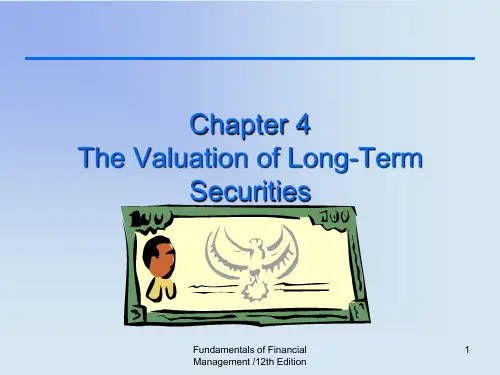

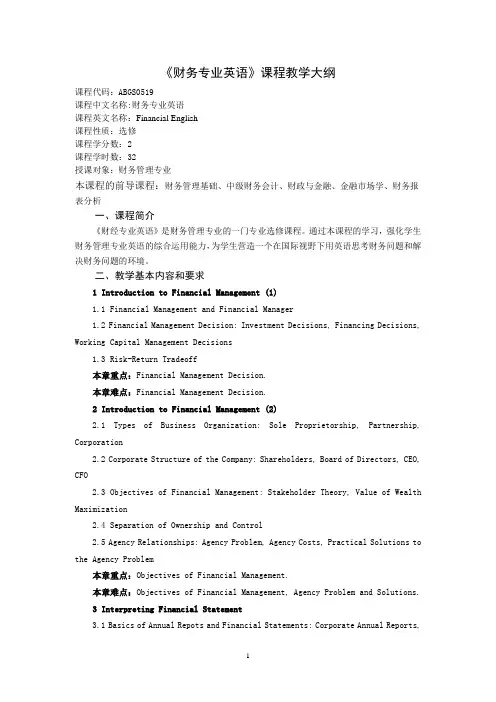
《财务专业英语》课程教学大纲课程代码:ABGS0519课程中文名称:财务专业英语课程英文名称:Financial English课程性质:选修课程学分数:2课程学时数:32授课对象:财务管理专业本课程的前导课程:财务管理基础、中级财务会计、财政与金融、金融市场学、财务报表分析一、课程简介《财经专业英语》是财务管理专业的一门专业选修课程。
通过本课程的学习,强化学生财务管理专业英语的综合运用能力,为学生营造一个在国际视野下用英语思考财务问题和解决财务问题的环境。
二、教学基本内容和要求1 Introduction to Financial Management (1)1.1 Financial Management and Financial Manager1.2 Financial Management Decision: Investment Decisions, Financing Decisions, Working Capital Management Decisions1.3 Risk-Return Tradeoff本章重点:Financial Management Decision.本章难点:Financial Management Decision.2 Introduction to Financial Management (2)2.1 Types of Business Organization: Sole Proprietorship, Partnership, Corporation2.2 Corporate Structure of the Company: Shareholders, Board of Directors, CEO, CFO2.3 Objectives of Financial Management: Stakeholder Theory, Value of Wealth Maximization2.4 Separation of Ownership and Control2.5 Agency Relationships: Agency Problem, Agency Costs, Practical Solutions to the Agency Problem本章重点:Objectives of Financial Management.本章难点:Objectives of Financial Management, Agency Problem and Solutions.3 Interpreting Financial Statement3.1 Basics of Annual Repots and Financial Statements: Corporate Annual Reports,Overview of Financial Statements3.2 Balance Sheet3.3 Income Statement3.4 Statement of Retained Earnings3.5 Statement of Cash Flow: Operating Cash Flows, Investing Cash Flows, Financing Cash Flows本章重点:Interpretation of Financial Statements.本章难点:Interpretation of Financial Statements.4 Financial Ratio Analysis4.1 Financial Ratio Analysis4.2 Liquidity Ratios: Current Ratio, Quick Ratio, Cash Ratio4.3 Debt Management Ratios: Debt Ratio, Long-term Debt Ratio, Cash Flow Coverage Ratio4.4 Asset Management Ratios: Accounts Receivable Turnover Ratio, Inventory Turnover Ratio, Accounts Payable Turnover Ratio, Asset Turnover Ratios4.5 Profitability Ratios: Gross Profit Margin, Operating Profit Margin, Net Profit Margin, Return on Assets, Total Return on Assets, Return on Equity, Return on Common Equity, DuPont Analysis of ROE4.6 Market Value Ratios: Price/earnings Ratio, Market-to-book Value Ratio, Dividend Yield and Payout4.7 Uses and Limitations of Financial Ratio Analysis本章重点:Principle Financial Ratios.本章难点:Calculation and Signification of Principle Financial Ratios, DuPont Analysis.5 Time Value of Money and Valuation5.1 Central Concepts in Financial Management5.2 Simple vs. Compound Interest Rates and Future vs. Present Value: Simple Interest, Compound Interest, Future Value, Present Value5.3 Annuity: Ordinary Annuity, Annuity Due, Deferred Annuity, Perpetuity, Nominal and Effective Interest Rates5.4 Valuation Fundamentals: Going-concern Value, Liquidation Value, Book Value, Market Value, Intrinsic Value, Valuation Approaches, Discounted Cash Flow Valuation5.5 Bond Valuation: Contractual Provisions of a Typical Bond, the Bond Valuation Formula, Bond Prices and Returns5.6 Common Stock Valuation: Common Stock Characteristics and Features, Common Stock Valuation本章重点:Compound Interest Rates, Future Value, Present Value, Annuity, Valuation Approaches.本章难点:Present Value of Different Annuity.6 Risk and Return6.1 Introduction to Risk and Return: Return, Risk6.2 Efficient Market Hypothesis (EMH): Introduction, Financial Market Efficiency, Anomalies in Finance6.3 Portfolio Theory: The Expected Return of a Portfolio, Risk in a Portfolio Context, Modern Portfolio Theory, Diversified Risk versus Market Risk6.4 Beta and Capital Asset Pricing Model: The Concept of Beta, CAPM6.5 Arbitrage Pricing Theory本章重点:CAPM.本章难点:CAPM.7 Capital Budgeting7.1 Capital Investment Decisions: Nature of Capital Budgeting, Project Classifications7.2 Guidelines for Estimating Project Cash Flows: Incremental Cash Flows, Focus on After-tax Cash Flows, Postpone Considering Financing Costs, Other Cash Flow Considerations7.3 Investment Rules: Payback Period, Net Present Value, Internal Rate of Return, Profitability Index7.4 Business Practice7.5 Analyzing Project Risk: Sensitivity Analysis, Break-even Analysis, Simulation7.6 Project Selection with Resource Constrains7.7 Qualitative Factors and the Selection of Projects7.8 The Post-Audit本章重点:Capital Investment Decision Indices.本章难点:Internal Rate of Return.8 Capital Market and Raising Funds8.1 Financial Markets: Role of Financial Markets, Types of Financial Markets, Recent Trend8.2 Investment Banks: Advising, Underwriting, Marketing8.3 The Decision to Go Public: Advantages of Going Public, Disadvantages of Going Public, Different Methods of Issuing New Securities8.4 Cost of Capital Concept: Use of the Cost of Capital, Capital Components, Weighted Average Cost of Capital本章重点:Cost of Capital.本章难点:Cost of Capital.9 Capital Structure9.1 The Choices: Types of Financing9.2 The Financing Mix9.3 Understanding Financial Risk9.4 Capital Structure and the Value of a Firm: The Modigliani-Miller Theorem, The M&M Theorem in the Real World, Tradeoff Theory of Optimal Capital Structure, Pecking Order Theory of Capital Structure9.5 Checklist for Capital Structure Decisions本章重点:Capital Structure Decisions.本章难点:Capital Structure Decisions.10 Dividend Policy10.1 Dividends and Dividend Policy: Dividend Payout Procedure, Types of Dividends10.2 The Dividend Puzzle: Dividend Irrelevance Theory, Dividend Relevance Theory10.3 Factors Influencing the Dividend Decision: Shareholder Factors, Firm Factors, Managerial Preferences and Constraints10.4 Dividend Policies: Residual Dividend Policy, Stable Dollar Dividend Policy, Constant Dividend Payout Ratio, Low Regular plus Specially Designated Dividends10.5 Stock Repurchases: Ways of Repurchases, Reasons for Stock Buybacks本章重点:Dividend Policies.本章难点:Stock Repurchases.11 Working Capital11.1 Introduction to Working Capital Management11.2 Cash Management: Three Motives for Holding Cash, Determining Appropriate Cash Balances, Investment Idle Cash, Types of Money Market Securities, Managing Collections and Disbursements11.3 Accounts Receivable Management: Credit Policy, Collection Policy11.4 Inventory Management: Successful Inventory Management, The Purchasing Plan, Inventory Management Techniques本章重点:Motives for Holding Cash, Determination of Appropriate Cash Balances.本章难点:Determination of Appropriate Cash Balances.12 International Financial Management12.1 Introduction: The Global Economy, Multinational Corporations12.2 Foreign Exchange Market: Exchange Rates, Currency Risk, Types of Transactions12.3 Exchange Rate Parity: Interest Rate Parity, Purchasing Power Parity, Unbiased Forward Rates, Inflation, Interest Rates and Exchange Rates12.4 Multinational Capital Budgeting12.5 International Financial Decision12.6 Working Capital Management12.7 Hedging Currency Risk: Currency Forward Contracts, Currency Futures Contracts, Currency Swaps, Currency Option Contracts本章重点:International Financial Decision.本章难点:Hedging Currency Risk.三、实验教学内容及基本要求无四、教学方法与手段教学方法:理论教学、案例教学、启发示教学、情境教学教学手段:板书教学、多媒体教学五、教学学时分配六、考核方式与成绩评定标准1、考核方法:集中考核(考核方式:考查)2、成绩评定:平时成绩(考勤、课堂表现及作业)占40%,期末考核成绩占60%。
